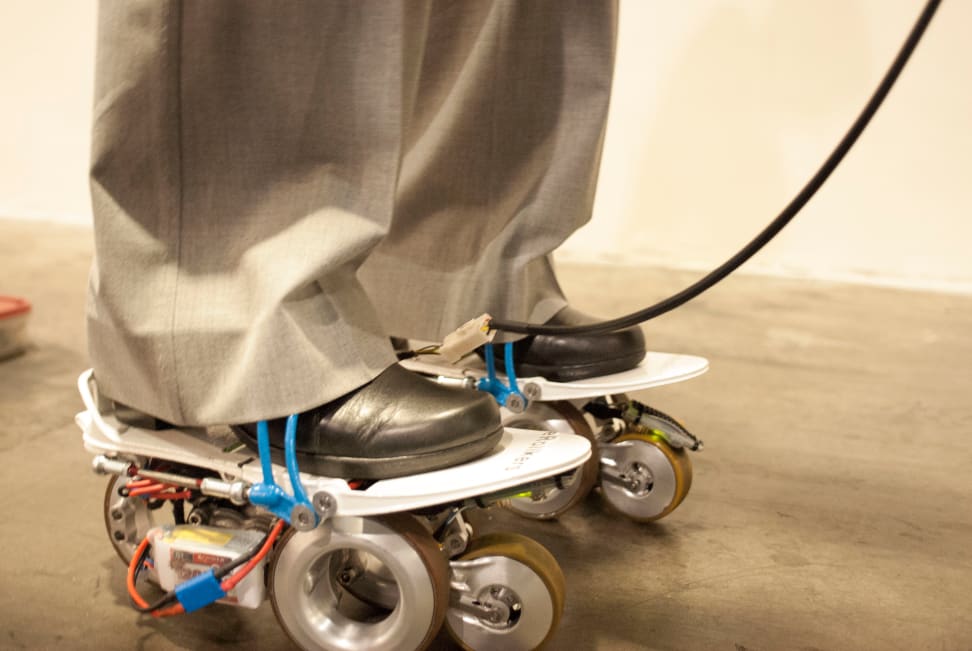Personal Transportation Devices Abound at CES
Rollkers, RocketSkates, IO HAWK—the future of personal transit?
 Credit:
Reviewed.com / James Johnston
Credit:
Reviewed.com / James Johnston
Products are chosen independently by our editors. Purchases made through our links may earn us a commission.
Personal transportation devices, like roller skates and skateboards, are simple. They require a varying amount of physical input from the user, along with some skill and balance. While these devices are, of course, still around today, each year brings a new batch of technologically-enhanced devices that make improvements on the classic designs... or not.
At CES this year, we had a chance to experience a few enhanced personal transportation devices, and here's what we thought.
Rollkers
The Rollkers are in an early prototype stage, but the concept is pretty nifty: They're supposed to let you walk around as if you're on your own personal moving walkway. They'll work with any shoe you can wear—no difference between heels or flats or boots. Your feet snap into Rollkers like you're stepping into ski boot bindings. Each time you put your foot on the ground, the motors under each foot will propel you along at speeds of up to 7 MPH.
These futuristic roller skates can slow down or speed up as it detects a change in the pressure from your feet. You can set personal parameters via a companion app, such as the top speed at which you'd like to travel, or whether you'd prefer hard stops or more gentle deceleration.
We had a chance to test out the prototype on the show floor. While they still have a ways to go in terms of design, it was clear that the Rollkers could transform the daily commuting experience for people who already walk or would like to walk to work.
{{ photo_gallery "rollkers" }}
RocketSkates
RocketSkates are another new personal transportation device. Developed for kids who grew up with Heelys, RocketSkates tout themselves as fashion tech, meant to look cool while being the smallest, lightest form of transportation you can fit in a backpack.
{{amazon name="ACTON R10 RocketSkates - The World's First Smart Electric Skates (Black)", asin="B00MFS8EFI", align="right"}} The RocketSkates have two wheels on either side of your foot. The boot cup is just like that of a snowboard—it comes midway up your calf, has padding on the inside, and an overshoe clip that, when tightened, snugs your foot into the boot. The skates are meant to be worn with your regular shoe, but we found that heels made the device much more challenging to use.
To make the RocketSkates move, you have to tip your front toes up, push your foot forward, and then raise your back toes off the ground. Once the front wheels are moving, the motor kicks in and carries you forward. Tilt your toes down to move faster, toes up and heels down to stop.
ACTON, the company that makes RocketSkates, claims you can fit them in a backpack or simply walk in them; however, we found you'll need to be up on your toes. With a 7 pound weight hanging off each heel you're not likely to travel far. A few stairs here and there would be fine but not several flights. Also, we are a bit skeptical about carrying them in a backpack, given how much space they're likely to take up.
The RocketSkates were really fun to ride, but there's definitely a learning curve. There were very few people who seemed to pick it right up away; we spent about 5 minutes on them and would definitely need more time before taking them out in public. Luckily, RocketSkates come with a companion app that allows you to set the skates' difficulty mode: Beginner, Normal, or Pro. RocketSkates start at $499 for a pair with a battery that will propel you 6 miles on a single charge.

ACTON RocketSkates
IO HAWK
The IO HAWK is a single board that you stand on with one wheel on either side. Each footpad tilts independently, and there are blue LEDs along one side that blink when you turn—a bright blue turn signal. Gyroscopes and motors work in conjunction to move you in any direction you chose. Representatives here reluctant to compare the device to the Segway, but we couldn't help conflate the two in terms of technology and style of movement. The IO HAWK is a much less obtrusive device, however, with significantly higher maneuverability.
Before we tried out the IO HAWK on the show floor, our instructor told us to simply think about where we wanted to go and the IO HAWK would respond accordingly. Admittedly, we were skeptical, but it took us only about 2 minutes to relax on the IO HAWK and that, as they say, was that.
We were zooming up and down the show floor and doing fancy spins simply by thinking about where we wanted to go. The muscle movements needed to get the IO HAWK moving were so small that we were asked by onlookers if we were really controlling the device ourselves. The IO HAWK stops on a dime and can go as fast as 6.2 miles per hour. This gadget is available for $1,800.
{{ photo_gallery name="IO HAWK" }}
These three transportation devices may all seem similar, but each one seems to fit within its own niche. The Rollkers are best suited for commuters; RocketSkates were created for the college crowd; and IO HAWK just is a really fun toy. (Although it could also have some interesting applications for people with mobility issues.)
There were other personal transportation devices at CES, such as scooters, electric bikes, and a motorized board with a giant wheel in the middle. It's rarely a bad idea to ditch the car and explore the world on foot... Well, foot-ish.
